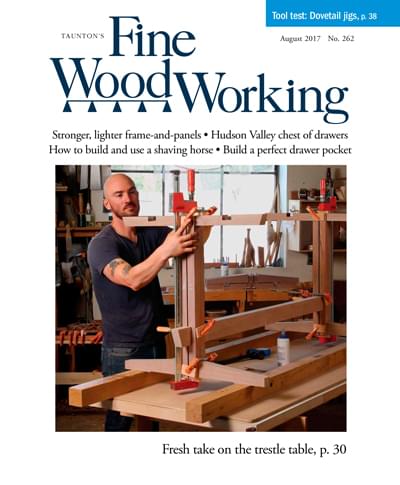Japanese Garden Bench
Mortise-and-tenon joinery and outdoor-friendly materials ensure a long, happy life for this Asian-inspired bench.

Synopsis: Russell Jensen designed this bench with a blend of traditional Tudor and Asian styles. The curved armrests, crest rail, and tapered back splats contribute to the Asian feel, while the chunky front legs and angled back legs are strictly Tudor. The angled rear legs are shaped on the tablesaw using a tapering jig. Simple mortising jigs ensure that the 40 different mortises used to join the bench are completed quickly and accurately. Jensen used teak for his bench, but gives advice on choosing other outdoor-friendly woods that would work.
A client approached me about a Tudor-style garden bench I had made for the local university. She loved the bench, but wanted something more Asian in style. I decided to incorporate elements from Gary Rogowski’s Asian-style bed, adding a curved back rail and armrests as well as tapered back splats with a cross rail between them. The final design is a…
Start your 14-day FREE trial to continue reading this story.
Plus, access more than 1,900 in-depth articles and more when you become a member.
Start Your Free Trial NowAlready a member? Log In







Comments
The angled vertical plane of the back is offset from center moving it forward. If this is not done the back will be uncomfortable to sit against, as your back will rest on the Crest Rail only with no lumbar support. This makes the design a bit awkward. Most benches will place the back plan between the back legs (not over top) and to keep the thinner dimension of wood of the back in the same alignment, and centered on the legs, for comfortable sitting. The article does not cover this aspect well as it is focused on router techniques vs design. Moreover the illustration misrepresents that the back is moved forward. It also shows a 3/4 tenon and the actual picture it is 1/2 inch. It is an important part of the design and your readers may be mislead on a project with expensive 12/4 wood.
Can't comment on the focus of the article being technique over design but the tenon discrepancy is a good catch. We are checking into it and I'll get you a response on that one soon.
-Ben
Quick question, what's the total number of board feet needed for this project please?
I'm slowly working through this project. I'd appreciate more information on working with epoxy on the M&T joints. Should an additive be used to thicken the epoxy? If so, how thick? How do you deal with squeeze out?
Log in or become a member to post a comment.
Sign up Log in